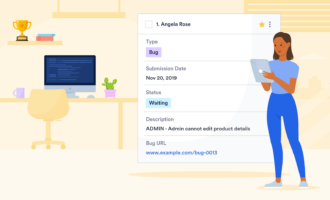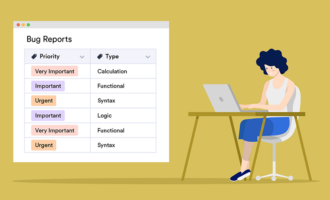Regardless of how well you’ve developed your software, bugs are unavoidable. Sometimes the bugs are small annoyances; other times they can bring your solution to a screeching halt.
To keep your customers happy and your developers on track, you need a solution that helps you organize and prioritize bug reports. We asked experts in the industry for their favorite bug tracking tools. See which one may fit the bill for your team.
1. Jotform Tables
Though known primarily as a form builder, Jotform provides a suite of productivity tools that now includes Jotform Tables. Bugs reported internally or externally via forms will automatically flow into the associated workspace in Jotform Tables, creating a one stop-shop for issue collection, tracking, and management.
Mustafa Oger, VP of Product at Jotform, mentions that “through a one-click sharing feature, you can give IT and product development teams access to collaborate on bug tracking tables.” Jotform Tables offers 40 tracker templates you can use as-is or customize to your needs.
2. Jira
Jira claims to be “the #1 software development tool used by agile teams.” It’s a comprehensive solution that includes a combination of project management, reporting, and bug tracking features, along with a host of integrations to expand its capabilities.
Vlad Anhelov, quality assurance engineer at HelpCrunch, says Jira is probably the most well-known tool in software development. He values the numerous third-party integrations with solutions such as GitHub and Slack. “Jira really helps with prioritizing tasks, linking issues, and ensuring no one misses a beat with its many types of notifications,” Anhelov says.
3. Redmine
Anhelov labels Redmine as a popular alternative to Jira for startups and small businesses. Like Jira, Redmine is a project management and issue tracking tool. However, Redmine is open-source and free, which makes it a great option for those on limited budgets.
“Another advantage of Redmine is that you can install it on your servers, plus get unlimited cloud storage,” Anhelov explains. “Like Jira, Redmine also has a GitHub integration, which is a key asset for software developers.”
4. Bugzilla
Bugzilla is a pure bug tracking system that allows you to enter and modify bug entries through email. Anhelov recommends Bugzilla because “it’s free, open-source, and has a simple and clear interface.”
With Bugzilla, you can bulk import any number of bugs from Excel files and take advantage of features such as scheduled reports, time tracking, and private attachments and comments. Administrators are able to create custom fields and workflows to tailor the solution for their team’s unique needs.
5. BugHerd
BugHerd is advertised as a feedback tool for websites, particularly for collecting and acting on client feedback. The tool is visual, enabling someone to log a bug quickly using a sticky-note-like feature that a developer can access directly from the web page at any time.
Maksym Babych, CEO at SpdLoad, likes BugHerd because it’s well organized. The solution coordinates bugs in four major status categories — backlog, to do, doing, and done. “These categories enable the testing team to keep up with the status of diverse bug tracking tasks,” Babych explains. “The solution also captures a screenshot of the issue for additional context.”
6. ReQtest
ReQtest is a requirements management, test management, and bug tracking solution aimed at helping companies manage IT projects. You can capture, track, and manage bugs; make use of charts and filters; and add images or videos with voice-over to your bug reports.
Babych is drawn to ReQtest’s extensive test management features and intuitive test management process. “Also, its agile board offers an effective way to visualize tasks and identify bottlenecks quickly,” he adds. “As far as multifaceted bug tracking tools go, ReQtest is a good pick.”
7. DebugMe
Like BugHerd, DebugMe focuses on helping users see issues, enabling them to provide visual feedback right on your website. DebugMe aims to eliminate the back and forth that comes with emailing developers about bugs.
The platform features a toolbar that lets you draw, highlight, black out, pin, and make notes on a webpage for context-driven bug reporting. Kenny Trinh, CEO of NetbookNews, says DebugMe is a “handy tool for not only tracking bugs but also managing software-related projects.”
8. Usersnap
Usersnap enables you to collect actionable user feedback. When a user runs into an issue using your web-based tool, they can easily annotate the problem within the context of the screen. Metadata, such as the URL and user’s browser, is captured and submitted automatically.
Trinh says the great thing about Usersnap is that testers can not only create bug reports but also annotate screenshots. “The bug report is sent to your project dashboard, where you can organize your process steps in various lists and views,” Trinh adds.
Each of the above bug tracking tools has a unique set of features that complement bug tracking. Choose one that best fits your needs and budget.









Send Comment: